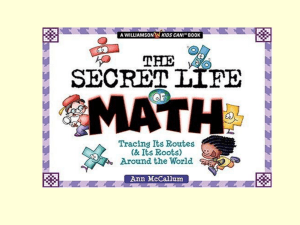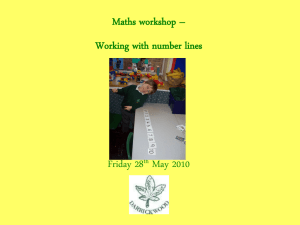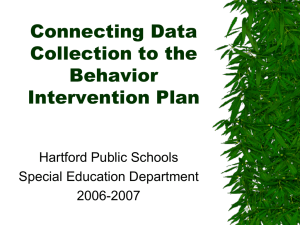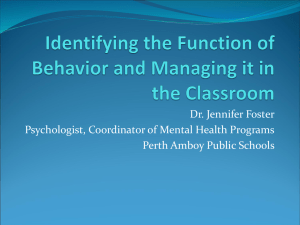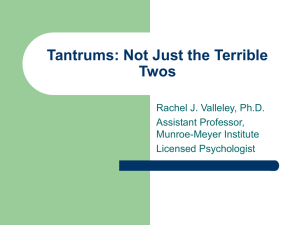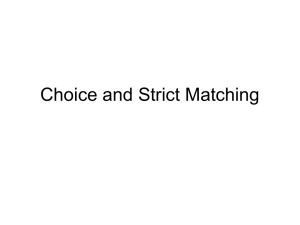PowerPoint - University of Maine
advertisement
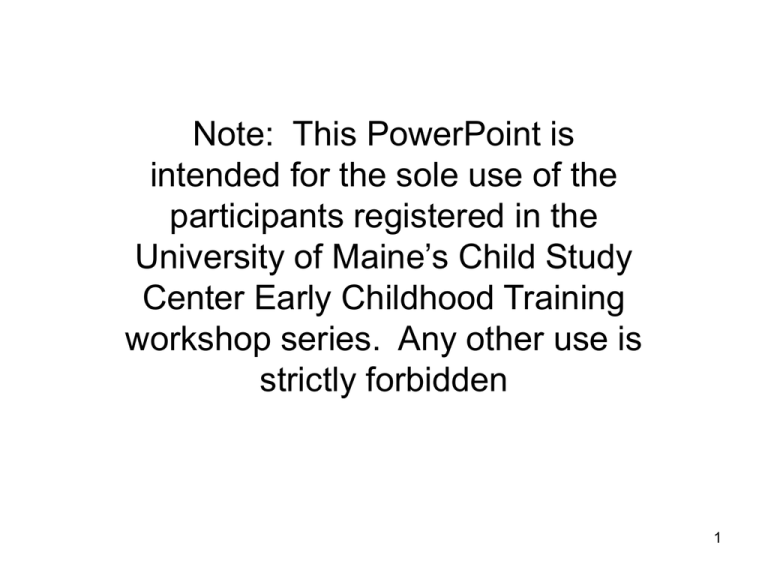
Note: This PowerPoint is intended for the sole use of the participants registered in the University of Maine’s Child Study Center Early Childhood Training workshop series. Any other use is strictly forbidden 1 A special Thank you to the Davis Family Foundation for their generous grant to fund the workshop series last year and this year. 2 University of Maine’s Child Study Center Early Childhood Training Program 3 Classroom management and reducing behavioral problems in children. • Decrease the Child’s opposition with teachers • Decrease negative behaviors and noncompliance • Decrease peer aggression and disruptive behaviors in the classroom 4 What are symptoms of opposition and negative behaviors and noncompliance? 5 • ODD: Oppositional Defiance Disorder • ADHD: Attention Deficit Hyperactive Disorder • ADD: Attention Deficit Disorder • Temper tantrums • Different from natural development (terrible 2’s, early teen years) 6 ODD can cause clinical impairment in social, academic or occupational functioning, and is characterized by a recurrent pattern of negativism, defiance, disobedience and hostile behavior toward authority figures which persists for a period of at least 6 months. (rules out natural development?) 7 • Learning disabilities is a term that describes a heterogeneous (mixed bag) group of disorders that impact listening, speaking, reading, writing, reasoning, math, and social skills. • Learning disabilities do not go away. 8 • The difference between normal “BAD” behavior and oppositional/defiant behavior is a matter of degree, frequency, and intensity. (Kevin and traveling, Mason and marker/door) • Children with defiant tendencies display disruptive behavior to the extent that it disrupts their learning, school adjustment, home life (lives) and sometimes with their social relationships. 9 ODD is frequently a co-morbid condition with ADHD, and can also be diagnosed along with Tourette Syndrome, Obsessive Compulsive Disorder, Anxiety and mood disorders, Aspergers, language processing impairments, sensory integration deficits, or even nonverbal learning disabilities. 10 • 50-65% of defiant children have ODD and either ADD or ADHD • 35% of these children develop some form of affective disorder • 20% have some form of mood disorder, such as bipolar disorder or anxiety • 15% develop some sort of personality disorder • Many of these children also have learning disorders. 11 Characteristics include obnoxious aggressive behavior and an intent to bother people, particularly authority figures. Authority figures include teachers, parents, older siblings, grandparents, and also may lash out at authoritarian rules (school attendance, bedtimes, homework deadlines, cleaning room, orderly desk, personal grooming and appearance). (not always ODD) *child and bedtime routine 12 Some of these children share many of the following characteristics: --They possess a strong need for control and will do anything to gain power --they typically deny responsibility for their misbehavior and have little insight into how they impact others (Ricky and his actions) 13 • The child is socially exploitive and very quick to notice how others respond, and then uses these responses to their advantage in family or social environments, or both. 14 The child can tolerate a great deal of negativity, in fact sometimes seeming to thrive on large amounts of conflict, anger and negativity from others, and are frequently winners in escalating battles of negativity. (teacher get red, teacher crying, I have a bad attitude) poker face --any attention is good attention, and if they can’t get good attention, they may go for negative attention 15 Partial list of characteristics seen in defiant children: • • • • • • • Getting angry easily Arguing and talking back Defying reasonable requests Bucking rules Intentionally bothering people Pushing the limits Not taking responsibility for mistakes or misbehaviors 16 • • • • • • Getting easily annoyed Being resentful, spiteful, or vindictive Speaking harshly Being brutally unkind when upset Seeking revenge Having frequent temper tantrums ( out of terrible 2’s timeframe) • Parents of these children describe them as being rigid and demanding from an early age. 17 • Causes: • 2 different theories Developmental theory: suggesting that the resistance is really a result of incomplete development. For some reason, these children never really complete the developmental tasks that normal children master during the toddler years. They get “stuck” in the 2-3 year old stage of child defiance and never really grow out of it. 18 Learning Theory: suggests that defiance develops as a response to negative interactions. The techniques used by parents and authority figures on these children bring about the disobedient behaviors. The parents are not to blame when this happens. The same techniques work out quite well for “normal” children. • Innate versus environmental 19 • Too much vs. too little structure • In an overly structured environment the parent is rigid and inflexible. They micromanage and come down hard on their children, controlling every aspect of their lives. (ex: Tiger mom, single child and overprotective parents) • Children can exhibit defiance when parents don’t provide enough structure by setting appropriate boundaries, or establishing and following through with consequences for misbehavior (Sam’s club). 20 • DOES MY CHILD HAVE SPECIAL NEEDS? • All children are different. • What’s causing the issue? – Sneakers, parent working more, illness at home, grandparent ill, money, parent issue (impending divorce, daddy doesn’t live with us anymore), loss of job, moving, family stress, death in the family. – Some of the disruptive behaviors are cause specific, and can be dealt with in a simpler manner. 21 • Look at your Childs temperament: – some shy kids are labeled introverts, social outcasts, “stuck ups”. – Some active kids are called hyper, difficult, mischievous, “purposely against me”. – Some temperaments can be changed or tempered, some we need to learn how to work with. (BREAKING A CHILD) 22 • How do you interact with your child? – Are you causing some of the issues? – Do you expect too much from your child? (EX: Mason, 4 year old and sitting, raising the bar) – How do you view your role as a parent: friend, teacher, guider? – How much give and take is there? – Are you clear in your expectations – We take courses/have training for our jobs, why not assistance for raising our kids? 23 ARE YOU THE INSTIGATOR? 24 • What is your temperament? • For a child you are the most important person in their life. • But that usually changes as they grow, and they will grow. • Are you adapting to them as they change? (no; why; can I; how come; pleeaassseee, mommy mommy mommy, daddy daddy daddy, what does this mean???) Objectively take a step back 25 • HOW IS THE FAMILY LIFE? • What affects one child may affect others. • Behavior issues can be learned by siblings. • Attention seeking by siblings or spouses. • How is married life? • Finances, work, drug & alcohol use. • Education level not always a great indicator of parenting skill 26 Avoiding conflict • Avoiding conflict is not avoidance, it’s akin to picking your battles • Clear language and expectations • Age appropriate (tall 3 year old) • Walk away • Keep calm • Find out the child's “end game” • What do you know about your child? 27 • Build on the positives, give the child APPROPRIATE praise and positive reinforcements when they show flexibility or cooperation. Put yourself in time out. • Apologize when you’ve made a mistake. Good modeling. • Manage your own stress. All work and no play… 28 How to decide too much vs. too little? or…. where can we find the perfect parent with all the answers? 29 • How pervasive a problem? • SOME SAY ONE 1 IN 14 TO 1 IN 7 HAVE BEHAVIOR ISSUES (7-15% OF POPULATION). • Are we pushing too hard, thus causing some of the problems? 30 • Preschoolers are expelled 3 times more frequently than children in grades K-12 31 • National Center for Early Development and Learning (2000) indicated that 46% of kindergarten teachers reported that more than half of the children in their classes were not ready for school, that is, they lacked the self-regulatory skills and emotional and social competence to function productively and to learn in kindergarten. • Will public pre-K’s help with this problem? 32 • Similarly, several Head Start studies suggested that between 16% and 30% of preschool children in those classes posed ongoing conduct problems for teachers. • Question: is it child, or teacher/parent, or both? (Party, shirts, language and soap,) 33 • The Early Child Longitudinal Survey (ECLS), in a national representative sample of over 22,000 kindergarten children, suggests that exposure to multiple poverty-related risks increases the odds that children will demonstrate less social competence and emotional regulation and more behavior problems than more economically advantaged children. 34 • How to diagnose behavior issues? • Across the board assessments ----Horribly expensive ---- insufficient personnel to conduct assessments ---- too long a time lag for treatment. ----Unnecessary? 35 Who should do the testing/screening to form a diagnosis? 36 • • • • • • Pediatricians See child infrequently See child short periods of time Rely heavily on parent feedback Training for behavior diagnoses? Direct observation of child’s issues? • Good part of a team approach 37 • Parents Lack of training Bias Professional understanding of issues? Understanding of developmental stages? Denial Checklists available (Dr. LaFreniere) Used by early education staff also 38 • There is increasing evidence to suggest that teachers efforts to involve parents in ways to support their children’s learning at home (through phone call, newsletters, suggested homework activities, etc,) and in developing coordinated home/school behavior plans have positive effects on children’s academic, social and emotional competence. Shouldn’t it be built into work week? 39 • • • • • • Early Education Staff Childcare, preschool, early public school Training Direct observation Time period of observation Comparison of other children of similar age • Interactions with family members • Unbiased (?) filler of the blanks 40 • Mental Health Professionals • Professional training • Access to comprehensive diagnostic testing materials • Knowledge of development • Interaction with early education staff and family • Facility to conduct therapies 41 • Who makes the diagnosis? EVERYONE WORKS TOGETHER 42 Diagnosis made, now what to do? Accept diagnosis? (I think you’re full of .., His father was the same way at that age,) Team treatment. Family, program and therapists working together. Clear, consistent communication a must. Follow treatment plan…can you? 10 experts, 6 different ways to proceed, which way do you go? 43 • For parents, follow the plan that you can STICK WITH. • Is there a weak link? Too difficult, too strenuous, too unnatural, too expensive plans may not work. If not workable, inform team immediately for revisions or additional assistance or services. 44 • For teachers in public school, special staff, supplies and scheduling are available. • For preschool/child care staff, backing of Director/supervisors essential, as well as other staff, and family. • One-on-one or additional staffing needed? • Workshops for staff specific to situation. • Patience and persistence to deal with situation. 45 • Treatment plans too numerous to mention here. • Medications • Herbal treatments • Diet (JUMPING ON ANOTHER CHILD) • Treatment facilities • In-home staffing/therapy • Respite care 46 Treatment needs to be designed for YOUR child and YOUR family or center. Whatever treatment plan chosen, done in conjunction with family. 47 • • • • • • • • • • • • 10+ C’s Clear language Calm manner Concise explanations/directions Consistent Caring Choices Consequences—taken away, given back Communication Changes Confidentiality +1 48 • Parent & family training & intervention (dog obedience classes) • Effect on family – Explanations (communication) – Individual time – Deal with perception of favoritism among siblings – Parent time (perfect parent?) 49 And now a word from our sponsor. 50 • When to effect change? • • • • • Only when ready to deal with issues/changes Talk about/discuss at a neutral time Don’t talk in front of children (parents/teachers) Make few changes at a time Parents (adults) on same page before enacting changes (ext. family, friends) • Time 51 Steps to take in dealing with targeted issues. Cognitive competence: a pupils general feeling of doing well at school. The anticipation of success probably promotes and enhances on-task orientation. Atkinson (1964) states that motivation is highest when the task is perceived as appropriately challenging and the chance of successful accomplishment is above 50% (Bru, 2006) 52 • Bandura (1997) maintains that a personal belief in self-efficacy influences how much effort an individual will expend and how long they will persevere in the face of obstacles or even failure (Bru, 2006). • Make the tasks, activities, programs more relevant and fun for the students--not watering down or dumbing down the materials, just making them apropos to the students. 53 Effective classroom management can help to decrease disruptive classroom behaviors and increase student engagement in academic tasks. Poor classroom management has been linked to long-term negative behavioral and social outcomes for students 54 • There is substantial evidence indicating that well-trained and supportive teachers who use high levels of praise, proactive teaching strategies, and non-harsh discipline can play an extremely important role in fostering the development of social and emotional skills and preventing the development of conduct disorders in young children. 55 • What type of praise? • Overdone and overused? • Using several names when dealing with specific issues • Storytelling (fishing story) 56 • Having a supportive relationship with at least one teacher has been shown to be one of the most important protective factors influencing high-risk children’s later school success (Webster-Stratton, 2008). “Don’t teach to be remembered, teach to be enjoyed”. (Kevin Duplissie, August 16, 2012). • (Best Buy, parade, SAT’s, MIT) 57 • Classroom management – Physical placement of chairs, desks, etc – Vision placement of staff – Discourage inside running aisles – Visually encouraging without too much “noise” – Height of materials for viewing and for use – Availability of useful materials – Permission for use? – Proper care of materials – Do children have ownership in program? 58 ESTABLISH ROUTINE 59 • Encourage participation of all children • Encourage participation of all staff • Encourage participation of families where and when appropriate • Encourage staff feedback to staff • Encourage staff feedback to parents • Encourage staff feedback to children 60 • Time for variety of activities • Play time inside and out – Large motor/large muscle play – Play with, but don’t overtake – Let child take some of the lead – Explain game, but remember learning curve – Don’t’ be afraid to be silly with child – Make the connection – Don’t preach 61 • Staffing • Appropriate number to meet program needs (public pre-k’s) • Appropriate language in program • Appropriate language to children: – Asking or telling? – Encouraging or discouraging? – Difference between “that’s a good job” and “I like the way you did XXXXX” – Variety of training programs – Bring in appropriate “self” 62 • Staff engaged with children Visual cues Verbal cues: language and tone Physical cues Staff placement Looking down or looking at Staff relationships with co-staff, parents, children and directors Staff wanting to be there It’s not just a job, it’s an adventure 63 • Modifications in program content – Divide materials into small manageable units – Present material in systematic fashion – Ex: numbers and counting – Posters – Varied counting materials available – Make a game of counting things at cleanup time – Make a game of counting boys and girls 64 • Adapt materials ex: Planting seeds – – – – – – – – Counting seeds Count cups needed for all kids Counting spoonfuls of sand needed Counting spoonfuls of water needed Counting how many days until sprouting Counting how many inches grown in day/week Draw pictures of activity Counting flowers/buds – Don’t overdo things—not everything needs to be a teachable moment 65 • Use clay/play dough to make the seeds • Place pictures children made on walls – Kids will go count “their stuff” on their own – Cook with items planted (peas for snacks, carrots for snacks, etc.) 66 67 • Additional presentations and practice – Show & Tell – Calendar time – Invite guests to discuss subject matter – Natural environment (Madison, STOP) Increased use of graphs, charts, posters, books Allow children access to these varied materials 68 69 • Active student and staff involvement – Present material in song fashion – Present material in dance fashion – Present material in drawn fashion – Create a game to present material and incorporate materials 70 Modifications in student work product adapt task characteristics/requirements clay, play dough, group work (cooperation, social networking, peer influence, peer measure) allow extra time (parents rushing in to go home) Still have expectations, but can they be adapted? 71 • DECREASING PEER AGGRESSION IN THE CLASSROOM (WORKS FOR HOME TOO). 72 • DEAL WITH THE ISSUE HEAD ON • Books: Baby Faces; If you’re angry and you know it; The way I feel; Why should I listen; Why should I help; I’m so grumpy; David goes to school; No David; Alexander and the terrible, Horrible, no good, very bad day; On Monday; It looked like spilt milk; I love school. • Great conversation starters • Book clubs 73 • Picture cards • Show me your XXXXXX face • What would you do if I came to school XXX? • If I had a bad day what could you do to make it better? • If YOU had a bad day, what could we do to make it better? • If YOU had a bad day, what could your parents do to make it better? 74 • Talk about Feelings DON’T SMILE!!!!!!!!!!!!!! 75 • If YOU had a bad day, what could YOU do to make it better? 76 MAKING A CHILD SAY SORRY 77 • Help them make choices: – Fingers – Repeat offenders – Choices and consequences – Shakespeare had it right: Thrice is mine… – Team consistency (including parents) – Face needs to show importance of words – Set the stage (semester starting, new child starting, CLEAR reminders of routine, rules and expectations) – ASK THE KIDS TO HELP 78 • Sharing • Emotions • Cooperation (use teachers for example, act it out) • Screaming and yelling 79 • Make school fun: • The Kissing Hand; Huggly goes to school; Spot goes to school; Mouse’s First Day; It’s Time for School Stinky Face; and others. • USE YOUR TALENTS • Ask KIDS for suggestions for snacks for the month • Field trips • Varied activities (woodworking) 80 81 • Is routine too rigid or structured? • Are the expectations of the children too high? • Is there adequate coverage? • Are there adequate staff????? • Do the staff have management support? • Do the staff have parental support? • Do the staff have each others back?***** 82 • Obtain objective assessment from staff who work with child. • Use checklists to verify objectivity • Are you in agreement that there is an issue that needs to be addressed? If so… 83 • Set up a meeting with parent's. • Assure them you are there for child and family. • Have examples of the “issue at hand”. • Are parents seeing issues at home also? 84 • Have specific examples of how you are dealing with issue at school. • Illustrate that staff and program are here to help with the issue. • Have paperwork (articles, program guides, etc.) as handouts to parents. • Ask if regular meetings would be of assistance? 85 Assure them that asking child to leave program is the last resort (and it should be last resort). 86 Use behavior charts How will staff use them? How will parents use them? Does the child know about them and what they are for? Do they go back and forth between school and home? 87 Rewards and punishment If they lose something (taken away, punishment), are they allowed to earn it back? How long before they receive reward? • Has that been explained well to child, staff and family? 88 The Daily and Weekly Point Sheet chart can be used to track progress. These charts can be modified to fit the individual child and/or teacher's needs. 89 90 • At the end of each week, a photocopy of the Weekly chart is made for the teacher's records. Students are then permitted to take their copy home. Some parents like to use these charts along with the daily point sheets to help motivate the students with rewards at home. 91 • Parents must be reminded to accentuate the positive. Periodically remind them that the point sheets and monthly charts are tools of communication. Help them see that even though a student may have low points for a particular day, he or she still may have made good choices. • Remind them of the positives, not just focusing on the negatives. 92 • REINFORCERS • The following list of reinforcers is only a start. Ask the students what they want to earn. Be observant to detect their least favorite activities. For the plan to work, there must be things students want to avoid as well as things they want to earn. 93 • Primary reinforcers include food items and drinks. These work best with younger students and with any age when stress factors are high. Permission from parents is sometimes needed. Primary reinforcers might include the following: • Candy Juice Fruit Crackers Soda Cookies • Cake Pizza Chips Pretzels Ice cream Marshmallows 94 • Secondary reinforcers include tangible items. It is wise to discuss in advance with the students what items they prefer to avoid purchasing too much. Free samples and donations are often available. Some suggested secondary reinforcers are: • • • • • Posters Erasers Cars Notebooks Sports cards Visors Nail polish Stickers Pens Sunglasses Caps Pencils Markers Clothing Cologne Dolls Bubble baths Jewelry Games Silly straws 95 • Social reinforcers are the highest level of reinforcement. It is not recommended that groups begin earning these at first unless adult supervision is always available. The students will be earning time and the right to use whatever materials are necessary. Points can be paid by the minute. 96 Painting Models Coloring Clay Playing outside Game time Computer Library Films Listening to tapes or records Visiting another classroom Helping in the office • Excerpted from Tough to Reach, Tough to Teach. 97 98 99 100 101 102 103 104 105 106 107 • What behaviors are you trying to change? 108 109 110 111 112 113 114 115 116 • Don’t forget the power of the words • I LOVE YOU • I’M PROUD OF YOU • YOU DID A GREAT JOB. 117 • DON’T FORGET THE POWER OF THE WORDS I LOVE YOU I’M PROUD OF YOU YOU DID A GREAT JOB 118 119 • DON’T FORGET THE POWER OF THE HUG. 120 • DON’T FORGET THE POWER OF THE TIME SPENT WITH MOM, DAD, OR TEACHER, OR DOING SOMETHING THE CHILD WANTS TO DO. 121 QUALITY NOT QUANTITY 122 • Not meant to be all-inclusive. • Can talk more about any of these slides in live workshop on Oct 26.. • Never stop learning from other teachers, parents, or the kids themselves. 123 REMEMBER TO HAVE FUN. They will grow up quickly. Before we know it, they are up & gone Don’t rush childhood. Don’t forget to smile. 124 125 • Upcoming workshops: • Toilet training. Please send your proven and creative tips to me to include for all to see and try. 126 Time for a fishing story? 127


